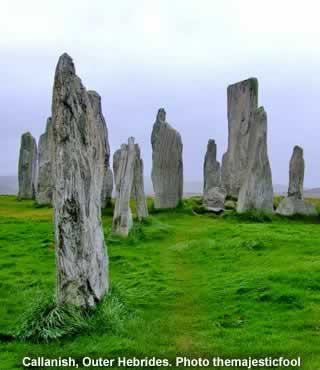Hebrides |
|
 |
|||
Britain > Scottish Islands > Hebrides |
A string of islands, dotted off the west coast of Scotland and considered to be one of the most beautiful places in the British Isles |
Listen to this article |
The Hebrides are a string of islands, dotted off the west coast of Scotland. They stretch out over about 130 miles, and are considered to be one of the most beautiful places in the British Isles. |
People have been living here since prehistoric times, and in fact, the islands still have several monuments dating back that far. The town of Callanish has several circles of mysterious standing stones, dating all the way back to the Stone Age - and in Cladh Hallan, archaeologists discovered the only human mummies in the UK. |
Unfortunately, as the islands grew older, they became the scene of much fighting and warfare. Raiders from Norway arrived sometime in the 8th or 9th centuries, and by the year 1098, the Hebrides were officially under their control. The fighting continued for centuries, with Scottish troops battling hard to try and wrest back their islands from the Norse. |
Thankfully, everything has since calmed down, and the Hebrides are now a quiet, relaxing place to visit. The islands have all the conveniences of the modern day, but coming here still feels like a visit to the past. It contains the largest collection of Scottish Gaelic speakers in the country - but don't be afraid to start up a conversation, because the local residents are known as being warm and welcoming. Between 1949 and 1953 the islands were even the location of a mass revival in Christianity with churches being filled and a yearning amongst the islanders towards living a disciplined godly life. |
The islands are generally split in half, known as the "Inner" and "Outer" Hebrides. The Inner group's largest and most well-known member is the island of Skye, which contains a population of less than 10,000 people. The spectacular landscape, wildlife, and culture have been popular with visitors for years - especially since the construction of the Skye Bridge in 1995, linking the island with the mainland. This bridge has been the subject of much controversy with many locals feeling it signalled the end to the island status of Skye. |
Travelling to the Outer Hebrides isn't as easy, although there are still plenty of ferry and air links. The airport at Barra is particularly notable for it's runway - planes come in for landing on a breathtaking three-mile stretch of beach, during low tide. Once you've arrived, the first destination is often the joined islands of Lewis and Harris. This is the most populous place in the entire archipelago, with nearly 20,000 residents. However, nearby islands are nowhere near as busy, with one claiming only 11 people! There are also dozens of uninhabited places to visit, meaning that there's lots to explore. |
Unfortunately though, if you do want to spend a lot of time outdoors, you should prepare to get wet! The Outer Hebrides sees an awful lot of rainfall - but on the other hand, this results in the incredibly lush greenery, which is one of the islands' trademarks. There's lots more to see too, from rugged mountains, to miles and miles of unspoiled beaches. In fact, the coastline here is so good that it has become incredibly popular with watersports fans. |
So whether you're after an action-packed week of climbing and surfing, or a quiet weekend getaway, the Hebrides has it all. It's unlike anywhere else in the country. |
|
Pocket Britain is optimised for use on a smartphone or tablet with internet access. All content is subject to copyright. All reasonable methods have been used to ensure information supplied is accurate at the time of publication. However, it is advisable to check information before relying on it. Privacy Policy |